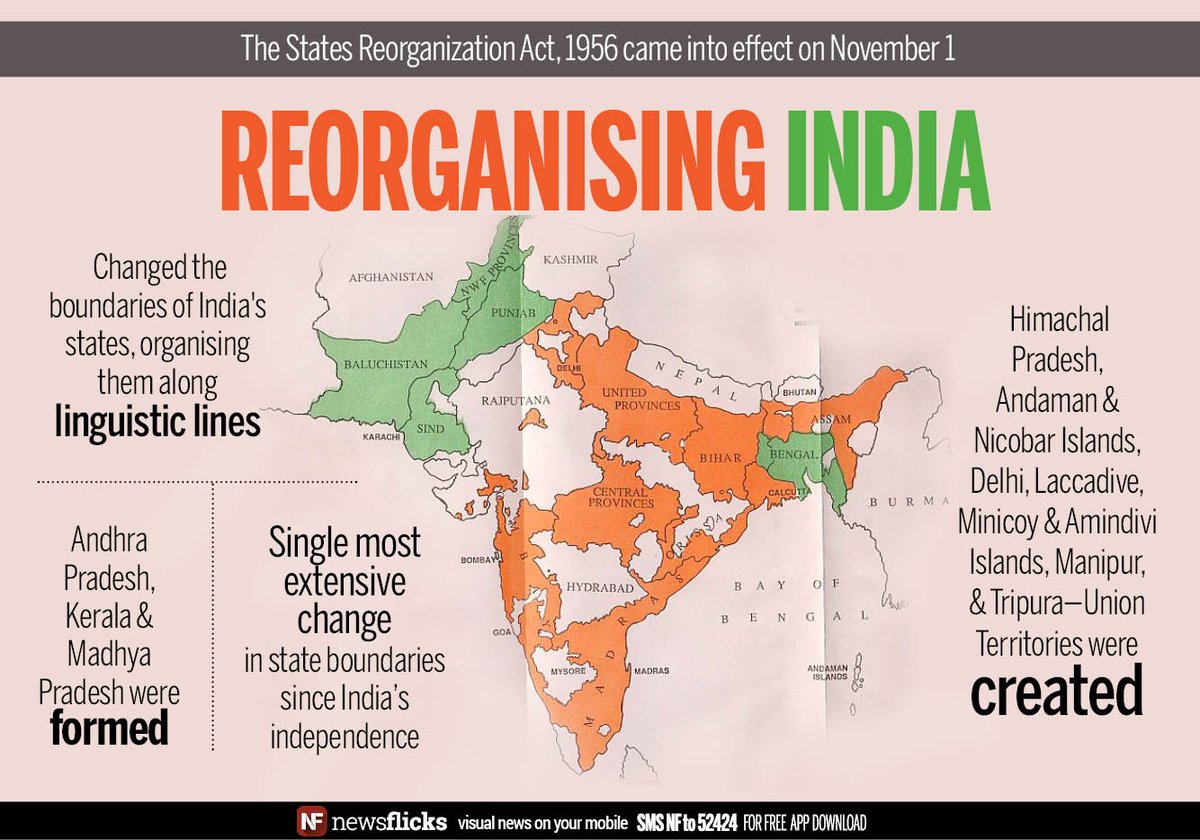November 1st: An Important Day in Indian History
Do you know when Haryana was established as the separate state of India? Read the blog to learn more
Mysore is noted for its heritage structures and palaces, including the Mysore Palace, and for the festivities that take place during the Dasara festival when the city receives many tourists from around the world. Take a look at the blog to know more about other states and cultures of India and their history.
The State Reorganization Act was Passed (1956)
The States Reorganization Act, 1956 was a significant change of the limits of India’s states and domains, arranging them along semantic lines. Although extra changes to India’s state limits have been made since 1956, the States Reorganization Act of 1956 remains the absolute most broad change in state limits since the autonomy of India on November 1, 1947. The Act happened simultaneously as the Constitution (Seventh Amendment) Act, 1956, which rebuilt the protected structure for India’s current states and the prerequisites to pass the States Reorganization Act, 1956 under the arrangements of Part I of the Constitution of India, Articles 3 and 4.
Read more: October 31: National Unity Day, All you need to know about

(Picture representing the reconstruction of Indian States)
English India, which included present-day India, Pakistan, and Bangladesh, was partitioned into two sorts of regions, the Provinces of British India, which were represented straightforwardly by British authorities dependable to the Governor-General of India and the Indian States, under the standard of nearby innate rulers who perceived British suzerainty as an end-result of their own realm, much of the time as setting up by settlement. Because of the changes of the mid-twentieth century, a large portion of the British areas had legitimately chosen assemblies just as lead representatives, albeit a portion of the more modest territories were administered by the main official designated by the Governor-General. Significant changes set forward by the British during the 1930s likewise perceived the standard of federalism, which was conveyed forward into the administration of autonomous India.
On 15 August 1947, British India was allowed autonomy as the different domains of India and Pakistan. The British broke up their arrangement relations with in excess of 500 august states, who were urged to agree to either India or Pakistan, while under no impulse to do as such. The majority of the states consented to India and a couple to Pakistan. Bhutan, Hyderabad, and Kashmir selected autonomy, despite the fact that the outfitted mediation of India vanquished Hyderabad and carried it into the Indian Union. Between 1947 and around 1950, the regions of the august states were politically coordinated into the Indian Union.
Most were converted into existing territories; others were sorted out into new areas, for example, Rajputana, Himachal Pradesh, Madhya Bharat, and Vindhya Pradesh, composed of numerous royal expresses; a couple, including Mysore, Hyderabad, Bhopal, and Bilaspur, became separate regions. The Government of India Act 1935 remained the sacred law of India forthcoming reception of another Constitution.
The new Constitution of India, which came into power on 26 January 1950, made India a sovereign popularity based republic. The new republic was additionally proclaimed to be an “Association of States”. The constitution of 1950 recognized three primary sorts of states and a class of regions:
Section A states, which were the previous lead representatives’ areas of British India, was administered by a lead representative delegated by the president and a chosen state council. The nine Part A states were Assam, Bihar, Bombay, Madhya Pradesh, Madras, Orissa, Punjab (some time ago East Punjab), Uttar Pradesh (previously the United Provinces), and West Bengal.
Part B states, which were previous royal states or gatherings of regal states, represented by a Rajpramukh, who was generally the leader of a constituent state, and a chosen assembly. The Rajpramukh was delegated by the President of India. The eight Part B states were Hyderabad, Jammu and Kashmir, Madhya Bharat, Mysore, Patiala, and East Punjab States Union (PEPSU), Rajasthan, Saurashtra, and Travancore-Cochin.
Part C states included both the previous boss officials’ regions and some august states, and each was administered by a central chief designated by the President of India. The ten Part C states were Ajmer, Bhopal, Bilaspur, Coorg, Delhi, Himachal Pradesh, Cutch, Manipur, Tripura, and Vindhya Pradesh.
The sole Part D territory was the Andaman and Nicobar Islands, which were managed by a lieutenant lead representative selected by the local government.
The States Reorganization Act was established on 31 August 1956. Before it became effective on 1 November, a significant revision was made to the Constitution of India. Under the Seventh Amendment, the current qualification among Part A, Part B, Part C, and Part D states was canceled. The qualification between Part A and Part B states was eliminated, turning out to be referred to just as “states”. Another sort of substance, the Union Territory, supplanted the grouping as a Part C or Part D state.
Other Events of this Day
1. Haryana was Established as a state of India as a carved out former state of East Punjab on 1 November 1966 with the capital city Chandigarh. It is ranked 22nd in terms of area, with less than 1.4% of India’s land area.
2. Karnataka is situated in the southwestern region of India which is the largest state in South India and the seventh-largest in India. It was formed on 1 November 1956, with the coming of the States Reorganisation Act. Originally known as the State of Mysore, it was renamed Karnataka in 1973. The state corresponds to the Carnatic region with the capital and the largest city is Bangalore.
Check our Instagram : Ownguru
Facebook : Ownguru
If you have an interesting write-up or any suggestion, write to us at ownguru@gmail.com
